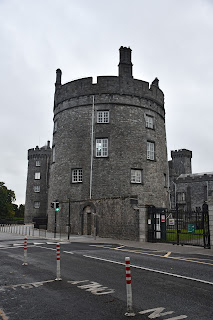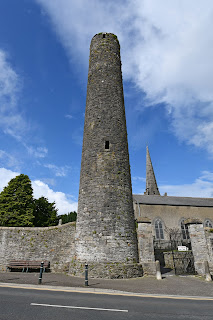Ireland: Day 7 – Kilkenny, Glendalough, and County Meath
I would have begun the day later, but the Airbnb where I was staying did not serve breakfast, and so – much like a migrating wildebeest in the vast savannah – I drove off at seven o’clock in search of food. Walking down the streets of Kilkenny, I eventually found a café. Predictably, the only establishment that was open at this hour on a Saturday morning was not a local enterprise but part of a chain I will not name.
Having eaten my
breakfast, I strolled around an empty Kilkenny, with enough money on my parking
meter to not have to care about the time. I wandered north all the way to Saint
Canice’s Cathedral and its round tower, likely the first major settlement on
the site of modern Kilkenny. In fact, Saint Canice – also known as Cainnech,
Kenneth, and Kenny – is the person after whom Kilkenny is named, with “Kil” (or
rather “Cill”) meaning “Church.”
From Saint Canice’s
Cathedral, I walked south again, passing by three churches: Saint Canice’s
Church, the Black Abbey, and Saint Mary’s Cathedral. By the time I had reached
the last of these, it was open, and I stepped inside to take a look at the
beautifully ornate interior. The apse was particularly interesting, depicting
scenes from the life of Jesus as well as several Irish saints. Finally, I
walked back to Kilkenny Castle where I had originally parked my car and
strolled around its just-opened gardens.
I lamented that it had
become sunny only when I decided to drive off, but by the time I reached
Glendalough about an hour and a half later, it had started raining again.
Glendalough is best known for its round tower, which can be seen peeking above
the treeline from the road; indeed, I am fairly sure that on a good day, it
must be visible from the overlook right above the picturesque valley. The round
tower, of course, once served as the centre of a monastic settlement. It
signalled hospitality to pilgrims from afar, and also served as a lookout post
for the monks.
The site of
Glendalough is associated with Saint Kevin, who had been to the valley as a
young man and returned with a retinue of monks after taking his vows. While he
was not one of Ireland’s “Twelve Apostles” who studied under Saint Finnian, he
was acquainted with some of them, including Saints Columba and Canice. Tragically,
he intended to visit Saint Cieran at Clonmacnoise, but upon his arrival found
that his colleague had died three days previously. One of the few remaining
well-preserved structures at Glendalough – besides the round tower and gateway
– is a church consecrated in Saint Kevin’s name.
My original plan for
the day had been to visit Dublin, but as I had already explored the city, I had
to come up with some alternative. I remembered that on my drive from Tara on my
third day, I had passed through a town called Trim. I had seen some impressive
ruins from the window, but I did not glean the importance of it until a later
Google search: it served as the caput of the important Lordship of Meath, and
it starred in the film Braveheart, which I have not seen but I am informed is a
classic. The website Irish Tourism claims that it is not only the biggest
castle in Ireland, but also the biggest Norman castle in the world (I am not
sure whether this is true, and comparing castle sizes is quite difficult
because it seems measurements are taken differently).
It took much effort
not to loudly curse the entire city of Trim during my half an hour-long hunt
for a parking spot. Having found one right upon entering the city, I discovered
that the parking meters only accepted coins. There were instructions for using
an app to pay, but of course the app did not accept my non-Irish phone number. Only
after driving aimlessly through the city for what seemed like a desperate
eternity did I find a barred parking lot. It too only accepted coins, but at
least I could park the car there while procuring them without getting fined in
the meantime.
Sourcing the necessary
funds proved easy: I ate at a restaurant and paid in cash. Indeed, I selected
my food based on a quick calculation of what price would give me the highest
number of coins; I suppose I could have just asked to exchange a banknote, but
that would have taken all the fun out of the exercise. With that sorted, I took
a quick look around Trim: beside the expansive castle, it also has a bridge
that is claimed to be the oldest bridge in Ireland. Notwithstanding this feat,
it continues to be a busy one and in fact received a lot of traffic from cars.
Half past three seemed
like far too early a time to end the day, so I let myself be inspired by one of
the tourist signboards in the area and drove to Kells. As advertised, the town
had its own round tower and several high crosses, as well as another parking
meter that only accepted coins (of which I luckily now have a decent supply).
The site at Kells is particularly interesting, as it was founded by Saint
Columba in the sixth century and re-founded in the ninth century by monks
fleeing Viking raids in Scotland. Appropriately, they brought with them Saint
Columba’s reliquary shrine.
My sources are unclear
on how many round towers there are in Ireland; some say that over a hundred
were built and that only around twenty remain in good shape, while other
sources estimate that there are now around sixty-five in various stages of
disrepair. It is, of course, perfectly possible for all these figures to be
correct, but going with the last number, I have now seen one thirteenth, or
almost eight per cent of the round towers in Ireland.

















































Comments
Post a Comment